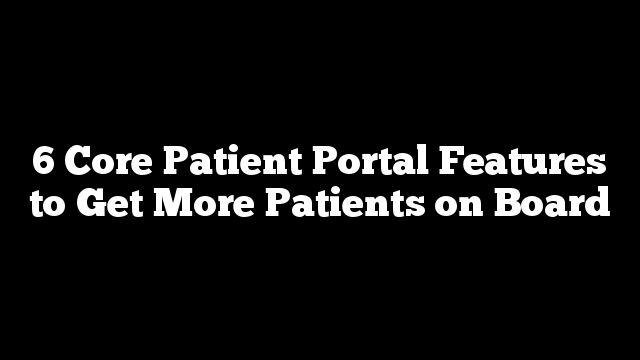
By SANDRA LUPANOVA
Healthcare providers are
moving forward with their digital initiatives, pursuing intranet development, implementing e-prescribing software, and deploying
EHR systems and patient portals to enhance patient care, maximize staff
efficiency, and improve the bottom line.
However, while medical professionals
are largely enthusiastic about digital healthcare solutions, the disparity
between the rate of clinical support and patient utilization of some of this
software, patient portals in particular, is enormous. Even though patient
self-service solutions have become ubiquitous in medical facilities nation-wide,
over 62% of US hospitals report that their patient portal systems are used by less than a quarter of all patients.
Patients still don’t see
enough value in patient portals, voicing concerns over the steep learning curve,
lack of training, anxiety regarding data security and confidentiality, and
other issues. Addressing these challenges is critical to encouraging patient
buy-in and getting more patients involved in their health.
Since most medical
facilities in the country already have patient portals in place, the next step
to overcome barriers to their adoption is to expand these systems to deliver
features that will get more patients involved.
A Friendly User Interface
A clunky and inconsistent
user interface is a major stumbling block that makes it impossible for many
patients to make it past the sign-up screen. Even if patients feel motivated to
use a self-service portal, when they crash upon a counterintuitive UI, their initial
enthusiasm quickly gives way to frustration and resignation.
Disappointing experience
with a patient portal can discourage patients from any further attempts to use it
in the future. For that reason, one of the first improvements to consider for any
existing patient self-service system should be UX optimization. A skilled frontend development team can enhance the design and navigation of any
patient portal to create a seamless user experience and keep patients involved.
An Effective Mobile App Combo
The smartphone
market penetration in the U.S. exceeds 70%. The general shift toward mobile devices also
impacts healthcare consumers, as they are increasingly engaging with their
health using mobile tools.
To address this trend, nation-wide
healthcare services suppliers such as UnitedHealthcare support patients with
custom mobile patient portal solutions that make it possible for the users to
take care of their health on the go. Smaller medical providers are also catching
up, leveraging out-of-the-box apps and extending them to deliver patient
self-service capabilities on mobile devices.
Digital Forms
Digital patient
registration forms ease the registration workflow by offering a simple and
time-efficient way for patients to fill out their details and consents before
the first appointment.
By reducing patient wait
time in medical facilities and enabling end-to-end secure control over the
submitted data, digital forms are a simple method of encouraging patient
communication. Online forms also benefit healthcare services suppliers by alleviating
the front-desk burden, minimizing the likelihood of clinical errors,
streamlining patient flow, and delivering a holistic view of a patient and their
medical history.
Many available patient
portals already support online registration; others can be easily extended with
custom functionality or integrated with one of the available off-the-shelf
solutions.
API Integration
While most patient portal
solutions by default support integration with core EHR systems, by extending an
open API, they can also connect to other third-party digital solutions and
medical IoT devices, such as step counters, glucose monitors, or sleep
trackers.
Considering the growing use
of wearables by US consumers that’s more than tripled since 2014, open APIs
become an instrumental feature of any patient portal.
When patients couple their
portal profiles with e-health wearable devices, they can automatically upload
and sync all their health data to gain a detailed insight into their health and
well-being over time.
Thanks to real-time
information flow between various tracking devices and health systems, physicians
can regularly and easily review patient vitals to make informed diagnostic and
treatment decisions.
Encrypted Messaging
Top patient portal
solutions, like those of Nextech, MyChart, or Athena, embed secure messaging to
offer an alternative to face-to-face medical appointments through asynchronous,
direct communication with physicians.
This type of interaction
can be of particular advantage to patients with chronic illnesses or mobility
issues, and those living in remote areas. Because of the highly-sensitive
nature of the data processed through patient portal systems and regulatory
compliance requirements imposed on healthcare providers (HIPAA, to start with),
all patient-doctor communication must be properly secured with data encryption.
Streamlined Payments
According to a report by TransUnion, 62% of patients say that knowing their healthcare expenses in advance impacts the likelihood of their pursuing care, while 68% of healthcare consumers fail to pay off their medical bill balances fully.
To resolve these concerns,
comprehensive patient self-service solutions such as Experian Health feature a
payment management component that supports a wide range of payment options,
providing patients with greater transparency when it comes to managing health finances.
These features include e-payments,
billing queries, insurance support, payment history and retrieval, and more. By
extending these features, healthcare organizations can not only augment patient
engagement and increase patient portal utilization but also monitor and manage
patient collections to boost recovery rates.
Toward a More Convenient Access to Healthcare
Healthcare organizations
make persistent efforts toward patient-centric, value-based care. Introducing
and enhancing patient portal solutions makes this task easier, allowing medical
providers to promote proactive patient self-care and spur meaningful patient interactions.
Empowering patients with a sense of authority and responsibility for their health with patient portals creates opportunities for better patient engagement, which in turn drives better treatment outcomes. On top of that, fostering patient activation through self-service patient software enables providers to become eligible for MIPS and other incentive programs and further refine the quality of their healthcare services.
Sandra Lupanova is SharePoint and Office 365 Evangelist at Iflexion, a software development and IT consulting company headquartered in Denver.
The post 6 Core Patient Portal Features to Get More Patients on Board appeared first on The Health Care Blog.
